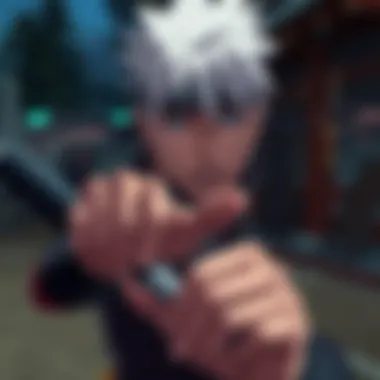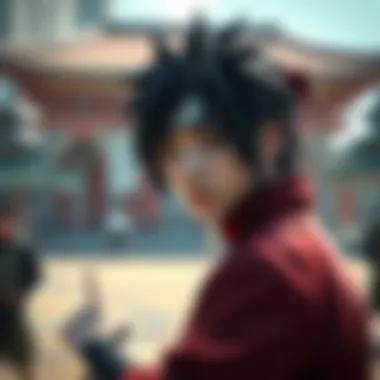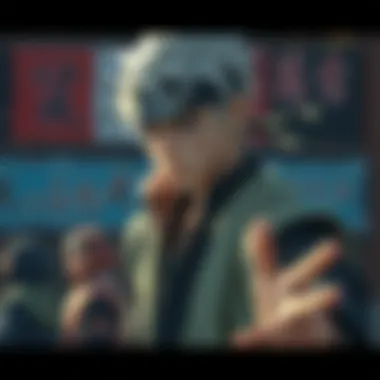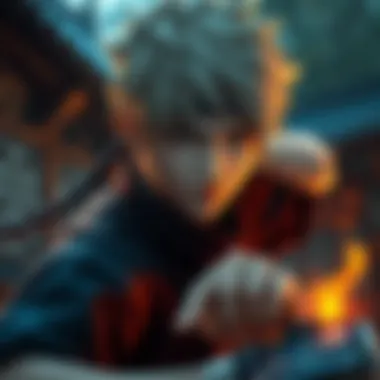Training Techniques and Philosophy in Konoha


Intro
In the realm of anime and manga, few narratives are as rich and varied as that of Naruto, set in the hidden leaf village of Konoha. The training techniques practiced by characters in this universe are not just methods of combat or growth; they symbolize deeper philosophies and traditions, reflecting the values and struggles of the village's inhabitants. Understanding these training practices offers insights into character development and the overall narrative arc of the series.
As one embarks on this exploration, it becomes clear that training in Konoha is a multifaceted experience. It encompasses not only physical endurance and skill acquisition but also philosophical principles that aim to forge strong bonds between ninjas, emphasizing teamwork, perseverance, and the instructor-student relationship. Each character’s training journey, therefore, tells a unique story, underscoring their growth and personal challenges.
Let’s delve deeper into some intricacies of Konoha's training philosophy and techniques, the historical influences that shape them, and the symbolism embedded within these methods.
The Essence of Konoha Training
The training practices in Konoha, the hidden leaf village, hold a considerable weight in the world of Naruto. They are not merely exercises or routines; they encapsulate a philosophy that intertwines the essence of personal growth, community involvement, and the grappling with one's own limitations. Understanding the essence of Konoha training is pivotal as it provides insight not only into the characters' developments but also into the overarching narrative that drives the series. The training regimes designed here are instrumental to fostering not only powerful shinobi but also resilient humans, capable of overcoming adversities through discipline and collaboration.
Historical Context
To appreciate Konoha's training essence, we must first backtrack to its historical origins. The village was founded on principles that valued unity, strength, and growth. The early days of Konoha saw significant figures like the First Hokage, Hashirama Senju, who emphasized the need for nurturing not just strength but also bonds with peers. This historical backdrop shapes how training is perceived and executed. The wars that plagued the ninja world spurred the need for effective techniques that could be taught to the next generation.
Training, therefore, became a mirror reflecting Konoha's values – endurance through trials, learning from mistakes, and cultivating a collaborative spirit. As the village faced threats, the evolution of training methods catered to both the disputes of the past and the uncertainties of the future.
Philosophical Foundations
At its core, Konoha training is underpinned by a philosophy that stresses perseverance and camaraderie. It hinges on concepts such as "Gaman," which translates to patience and endurance. This notion is pivotal, especially given that many shinobi face formidable challenges throughout their journeys. Training isn't solely about physical prowess; it's about mental fortitude, too.
This philosophy extends to teamwork, evident in how missions are often carried out in squads. The belief that individual strengths can be magnified through collaboration is crucial. One might say,
"Alone we can do so little; together we can do so much."
A statement every ninja seems to carry in their hearts during training.
Additionally, mentors play a significant role here. Figures like Kakashi Hatake and Might Guy embody the wisdom passed down through generations. They instill in their students not merely techniques but principles that guide their very essence as shinobi. Personal growth is thus just as essential as the mastery of jutsu.
Cultural Significance
Konoha's training holds cultural significance that extends beyond individual practice. It shapes social structures and community relationships. For instance, the rituals involved in training, such as group exercises and communal gatherings, foster a sense of belonging and identity among villagers.
Training is often perceived as a rite of passage. Young ninja, through their dedicated practice, earn their place and respect within the village. This process strengthens community ties and highlights the importance of support systems.
Moreover, the philosophical aspects of training have spilled over into other realms, influencing how conflicts are resolved outside of combat. The training fights not only hone skills but also enforce values of conflict resolution and understanding, which are essential in a world rife with strife. Indeed, the integration of these principles into everyday life makes Konoha's training an archetype worth exploring.
Training Techniques in Konoha
The art of training in Konoha is a complex tapestry woven with tradition, skill, and philosophy. These techniques not only enhance the physical abilities of the shinobi but also instill a sense of purpose and resilience. In the high-stakes world of the Naruto series, mastering various training methods is crucial for character development and plot progression. By delving into the training techniques prominent in Konoha, we can begin to appreciate how these practices shape the identities and capabilities of its warriors.
Ninjutsu Mastery
Ninjutsu serves as the backbone of a shinobi's arsenal. Mastery over ninjutsu is not merely about executing techniques; it's about understanding the elemental affinities that govern them. In Konoha, training involves rigorous exercises focusing on chakra control and manipulation, essential skills for any aspiring ninja.
A quintessential example can be seen in Naruto Uzumaki's journey. His training under the sage Jiraiya emphasized the importance of combining raw power with finesse in technique. Through relentless practice and a few close shaves with failure, he becomes adept at using the Rasengan, showcasing how dedication to ninjutsu can elevate a ninja’s capabilities.
Highlights of ninjutsu mastery include:
- Types of Ninjutsu: From elemental attacks to summoning creatures, each type requires distinct training approaches.
- Chakra Control: This is vital; without mastery over chakra, techniques can falter.
- Real-World Applications: Understanding how mastery can be applied in battle scenarios is crucial for effective training.


Taijutsu Fundamentals
While ninjutsu captures the spotlight, taijutsu—hand-to-hand combat techniques—form the essential foundation of shinobi training. The importance of mastering taijutsu in Konoha cannot be overstated; it is often the first line of defense against opponents.
In the series, Rock Lee exemplifies the beauty and discipline of taijutsu. Through sheer determination and rigorous training, he rises as a formidable threat, showing that physical skill can sometimes surpass even ninjutsu abilities. The challenges he faced due to his lack of ninjutsu only fueled his resolve to excel in physical combat.
Key aspects of taijutsu fundamentals include:
- Stamina and Strength: Building stamina is essential for extending fight durations.
- Speed and Agility: Training often includes agility drills to enhance reflexes.
- Techniques and Styles: Familiarity with various styles, like the Gentle Fist, offers different advantages in combat.
Genjutsu Application
Genjutsu, or illusionary techniques, represents a sophistication within training methodologies that often goes unappreciated. Unlike physical confrontations, genjutsu engages the mind, making psychological awareness a critical component for any Konoha ninja.
Characters such as Itachi Uchiha illustrate the depth of genjutsu application. His ability to manipulate perceptions forces opponents to confront their deepest fears, essentially turning their minds against them. Training in genjutsu typically involves work on focus, mental clarity, and vision—attributes that cannot be developed overnight.
Aspects of genjutsu application include:
- Mental Discipline: This is paramount when performing genjutsu effectively.
- Perception Training: Understanding how to read opponents' movements is key.
- Counter-Strategies: Knowing how to break free from genjutsu is equally essential, highlighting the importance of adaptive training.
Key Figures in Konoha Training
When it comes to the intricacies of Konoha's training, the weight of influence borne by key figures cannot be overstated. These individuals, ranging from established leaders to groundbreaking trainers, form the backbone of the training philosophy in the village. Their contributions extend beyond mere instruction; they shape the fundamental ideologies embraced by aspiring shinobi. Understanding these figures allows enthusiasts to grasp the subtle nuances in character development and the series' progression.
Hokage and Their Influence
The Hokage, as the village leader, holds a transcendent role in guiding the principles of training. Each Hokage brings their unique flavor to the village's training ethos. For instance, Hashirama Senju, the First Hokage, championed the ideals of unity and peace, actively promoting cooperative learning. His approach fostered an environment where collaboration was key to overcoming conflicts.
Other Hokages, like Naruto Uzumaki, forwarded training methods that emphasized individual strengths and personal growth. By integrating concepts like self-acceptance and overcoming adversity, he reshaped the modules and made them more relatable for younger generations. This evolution not only served to reflect the character development arcs vital to Naruto's story but also realigned the expectations for future shinobi.
A significant point to consider is how each Hokage’s philosophy resonates throughout the community, influencing emerging shinobi. They don’t just lead; they inspire principles crafted from their unique life experiences.
Prominent Trainers and Their Techniques
Beyond the Hokage, Konoha boasts a plethora of distinguished trainers, each wielding their own techniques and methods that push the boundaries of what is possible. One such figure is Might Guy, known for his unparalleled taijutsu prowess. His rigorous training exercises, such as the intense Morning Training Regimen, showcase the blend of physical discipline and mental fortitude required to excel in shinobi training.
Another noted trainer is Kakashi Hatake, whose mastery of ninjutsu and strategic thinking reshaped the way students approached combat. The Chakra Control Technique he advocated has aided countless shinobi in harnessing their abilities more effectively. It’s indicative of a broader trend where trainers not only impart skills but also shape the cognitive frameworks through which students view their challenges.
The impact of these trainers extends far and wide, influencing various generations. They serve not only as educators but also as personal mentors, establishing close-knit bonds that often lead to deeper understandings and greater loyalty among comrades.
Heroes Shaping Training Philosophies
Heroes in Konoha have also played a critical role in shaping training philosophies. Figures like Jiraiya and Tsunade have left indelible marks that go beyond their renowned abilities. Jiraiya’s teachings often revolved around resilience and the importance of imparting knowledge, emphasizing that true strength comes from their shared experiences and willingness to teach others.
Tsunade, renowned for her medical ninjutsu, foregrounded the significance of self-care and healing techniques in training. She highlighted that a shinobi's ability to survive hinges on understanding the body, thus integrating a profound respect for life into the training curriculum. These philosophies resonate throughout Konoha and guide the foundational teachings within the village.
"Training is not just about strength; it's also about the heart you bring with you. Understanding pain makes you stronger." - Jiraiya
Their lasting influence on current training doctrines emphasizes humanity and empathy, qualities that make the shinobi community resilient and united in their quests. These narratives fuel the ongoing evolution of Konoha's training techniques and empower new generations to engage with their ninja careers more meaningfully.
Ultimately, to appreciate the nuances of Konoha’s training, one must recognize the distinct contributions from these figures. Their legacies inspire currents of thought that resonate deeply within the narratives of the series, thereby enriching the viewing experience for both newcomers and long-time fans.


The Role of Team Dynamics in Training
In Konoha, team dynamics play a pivotal role in shaping not only the individual shinobi but also the fabric of the village itself. Collaboration among team members is essential for optimal growth and mastery of techniques. Each shinobi comes with unique skills, backgrounds, and personalities, which, when combined, enriches the training experience. This dynamic fosters an environment where learning becomes a collective pursuit, reinforcing the idea that one hero can only go so far alone. When they band together, they harness a different level of power and insight.
Collaboration and Growth
Collaboration in Konoha training is not merely a matter of convenience but a fundamental aspect of the shinobi philosophy. Through teamwork, individuals learn to appreciate each other's strengths and compensate for weaknesses. For instance, consider the formation of a typical shinobi cell—often consisting of a ninja with offensive prowess, one skilled in defense, and another adept in support techniques. This strategic balance ensures that the team can address various challenges effectively.
Several training exercises emphasize this collaboration:
- Joint Missions: These real-world simulations allow teams to apply their skills in synergy, crafting complex strategies together.
- Group Techniques: Overarching moves like the Rasengan or Sharingan require multiple participants to achieve their full potential, reflecting teamwork’s core principle.
- Feedback Sessions: After training, shinobi often gather to discuss performance, providing crucial insights into personal and group dynamics. This fosters growth through constructive criticism.
This intricate web of collaboration not only enhances individual capabilities but also solidifies the bonds necessary for survival in battle, making each member better prepared for the unpredictability of conflicts.
Mentorship Strategies
Mentorship within Konoha is the glue that keeps the training framework intact. Experienced ninjas, often Jonin or higher, take on the responsibility of guiding younger shinobi. This relationship is crucial for transferring knowledge and instilling values that define the shinobi way. Mentorship does not simply focus on techniques but also on ethics and the philosophy that underpins their duties.
- One-on-One Training: This allows emerging shinobi to receive personalized attention, honing their skills in a manner best suited to their learning styles.
- Shadowing Team Leaders: By observing seasoned ninjas in action, younger team members gain insights into strategic thinking and decision-making processes that can't be taught purely through lectures.
- Development of Emotional Intelligence: Good mentors also teach resilience and emotional control, lessons invaluable in high-pressure situations.
Mentorship strategies are designed not just for skill development, but for cultivating a sense of responsibility, honour, and team loyalty among new generation shinobi. The bond formed during such guidance often lasts a lifetime, influencing future training modules.
Conflict and Resolution in Training
Conflicts within training environments are almost unavoidable, particularly when dealing with diverse personalities and high-stakes learning. In Konoha, however, these conflicts are viewed not as setbacks but as opportunities for growth. The training process encourages shinobi to navigate these interpersonal struggles effectively.
- Encouraging Healthy Discourse: Teams are taught to voice disagreements respectfully, facilitating dialogue that leads to mutual understanding, rather than hostility.
- Role Reversal Exercises: Engaging team members in role-reversal scenarios can illuminate differing perspectives, allowing them to empathize with one another and resolve conflicts constructively.
- Team Retreats: Periodically, teams take time off from training to bond in informal settings. Such breaks provide an opportunity to create stronger emotional ties, helping resolve underlying tensions that may have arisen during intense training.
Addressing conflicts head-on helps forge a resilient team capable of withstanding external pressures. This not only prepares them for adversities in battle but also enriches their personal growth and understanding of collaboration.
"In spirit of a shinobi, only through cooperation can we truly reach our potential, both as individuals and as a village."
In summary, the role of team dynamics in Konoha training illustrates that a singular focus on individual prowess is overshadowed by collective strength. Through collaboration, mentorship, and effective conflict resolution, shinobi not only elevate their own abilities, but also cultivate enduring partnerships that are essential in facing the chaotic world they inhabit.
Challenges Within Konoha Training
The journey to becoming a skilled ninja is not merely a matter of physical prowess or technique in Konoha; it's a path riddled with challenges that test both body and mind. This section focuses on the formidable trials that aspiring ninjas face during their training. Understanding these challenges offers insight into the resilience and determination showcased by characters throughout the Naruto series. They symbolize not just martial skills, but personal growth, character development, and the persistence needed to overcome life's obstacles.
Physical Demands and Mental Toughness
The training regimen in Konoha is notoriously rigorous. Young ninjas engage in demanding exercises that push their physical limits. Be it extensive endurance runs through the Forest of Death or intense sparring sessions under the watchful eye of experienced mentors, these physical challenges play a pivotal role in shaping them into competent ninjas.
As they tackle these challenges, their mental toughness is tested equally. The link between physical training and mental strength is profound. Ninjas learn to push through exhaustion, harness pain, and maintain focus despite harrowing conditions. The philosophy is simple: if you can endure physical discomfort, you become stronger both in skill and character.
"Those who endure pain are the ones that truly grow. Each drop of sweat is a lesson learned."
This saying resonates throughout their training. It’s not just about the skills acquired, but the mindset developed during arduous moments. The physical demands require a solid mental foundation, which prepares ninjas for future battles where survival may depend on their resilience.
Overcoming Adversities
Adversities are par for the course in Konoha's training landscape. Whether it's facing a stronger opponent during practice or grappling with the pressure of expectations, each ninja encounters various hurdles. The ability to overcome these adversities is what sets the great apart from the good.


For instance, Naruto Uzumaki started off as an underdog. He faced not only the challenge of mastering ninjutsu but also overcoming the stigma of being the Nine-Tails' host. It’s through numerous trials that he learned the value of perseverance. Instead of allowing setbacks to consume him, he adapted and evolved, demonstrating the philosophical undercurrents of teamwork and support.
Overcoming adversity also emphasizes the role of mentors and comrades in this progression. The bonds formed during intense training sessions can act as a safety net, fostering camaraderie that empowers individuals to rise from failures.
Coping with Failures
Failure is an inevitable part of growth. In Konoha, it's a lesson often learned the hard way. Many ninjas, including the likes of Sasuke Uchiha and Sakura Haruno, face failures that momentarily hinder their journeys. Nevertheless, the narrative consistently highlights that failures are opportunities in disguise.
Coping mechanisms are crucial in these scenarios. The series illustrates various strategies for handling failure, from seeking guidance from teammates to looking inward and reflecting on one's techniques and beliefs. Acknowledging mistakes allows ninjas to recalibrate their approaches and persevere toward their goals instead of succumbing to despair.
Moreover, emotional resilience emerges as a core theme. The characters exemplify different responses to setback and struggle, demonstrating that the path to mastery is as much psychological as it is physical. In this respect, the training philosophy in Konoha merges skill acquisition with emotional development.
Future of Konoha Training
As we look to the future of Konoha’s training methodologies, it's essential to appreciate how these techniques not only resonate within the narrative of Naruto but also contribute to the development of new generations of shinobi. The challenges that lie ahead for Konoha are multifaceted, making the evolution of training programs imperative. Students and trainers alike are aware that adapting to modern techniques can yield significant benefits.
Integrating New Techniques
Konoha has always been a hub of innovation in ninjutsu, drawn from its rich history of diverse skills. Incorporating new techniques involves a careful blend of tradition and modern understanding. For example, we’ve seen elements of technology being introduced in training regimens, mirroring how societies often evolve. Presently, young ninjas could learn not just physical techniques but also strategic uses of data, akin to how modern martial arts exploit video analysis for performance improvement.
It’s worth exploring how legacy techniques are being transformed to include elements like combat simulations or virtual reality, allowing trainees to experience various scenarios without the physical limitations of field training. This optimization of training reduces risk and increases preparedness for real-life encounters.
"As ninjas inherit their teachers' wisdom, integrating fresh approaches ensures that they won’t just follow footsteps but carve their own paths."
Adapting to Modern Challenges
The shinobi world is changing. New threats arise that require unique responses, so adapting training methods is crucial. The anime illustrates this remarkably well, showcasing characters facing enemies that challenge traditional fighting styles. Konoha must respond to these modern scenarios by equipping its trainees with an arsenal that combines mental agility with combat skills.
Incorporating lessons on emotional intelligence, mental well-being, and adaptability play critical roles in preparing Konoha's ninjas for unexpected situations. Such skills foster resilience, enabling fighters to withstand both psychological and physical strains in battle. Moreover, as ecosystems evolve, understanding environmental factors and their impact on combat strategies can’t be overlooked.
Legacy and Continuity
Konoha's training is not merely about the here and now; it also concerns the legacy imparted through generations. Each Hokage has contributed to building a framework that honors the past while looking ahead. The continuity of such practices ensures that invaluable wisdom isn’t lost in transitions; rather, it adapts, evolving into something novel yet familiar.
The balance between respecting history and embracing the future is a hallmark of Konoha's training philosophy. As new techniques emerge and threats evolve, the need to comprehend and integrate foundational teachings becomes pressing. The mentorship programs underway make it clear that knowledge transfer is essential to ensure the village’s stability and strength as its youth step into increasingly turbulent times.
In summary, Konoha’s training journey is a testament to growth and adaptability. The ongoing evolution of techniques, the need to face modern challenges, and the preservation of legacy are cornerstones in preparing future generations to not only defend their village but thrive in a changing world.
Epilogue
The exploration of training methodologies within Konoha holds immense significance in understanding the nuanced layers of the Naruto universe. The rich tapestry of techniques and philosophies not only serves as the backbone of character development but also enhances the narrative arc across the series. This conclusion seeks to underscore several critical aspects that amplify the relevance of Konoha's training in the broader context of the storyline.
Firstly, reflecting on training practices reveals a fundamental element: growth through adversity. Characters such as Naruto Uzumaki and Sasuke Uchiha exemplify the impact of rigorous training on personal development. Their journeys are not merely physical; they encompass emotional and psychological challenges that are integral to their transformation. The environment of Konoha training fosters resilience, which stands out as a universal idea—adapt and evolve, or fall behind.
In addition, the dynamics of mentorship play a pivotal role in shaping not just the skills but also the values of the ninjas. The relationship between masters and pupils—whether it's Jiraiya and Naruto or Kakashi and his team—emphasizes guidance, learning, and respect. This mentorship intertwines the old with the new, ensuring that knowledge and skills pass from one generation to the next. Each character's growth is a testament to the philosophy that training extends beyond mere physical exercise; it is a complex interplay of mind, heart, and spirit.
Moreover, the significance of collaboration within Konoha is noteworthy. Training isn't merely a solitary pursuit; it's a collective endeavor often depicted in team missions. Characters learn to work together, blending their strengths to overcome challenges. This collaboration mirrors real-world scenarios where teamwork is essential, adding a layer of relatability for fans looking for deeper meanings in the storylines.
The diversity of training techniques illustrates the value of adaptability. Different ninjutsu, taijutsu, and genjutsu forms highlight that there’s no one-size-fits-all approach to challenges. Each character’s specializations and strategies are like fingerprints—unique and personal, which enriches the narrative and invites viewers to form connections with their journeys.
In terms of impact on the storyline, Konoha training serves as the engine driving character arcs forward. The challenges faced, lessons learned in the heat of battle, and personal triumphs echo throughout the plot, creating a symphony of interconnected tales. The profound themes of determination and overcoming obstacles resonate with anime enthusiasts, elevating their engagement with the narrative.
In summation, the examination of training at Konoha is more than a surface-level exploration of techniques; it roots in core philosophies that reflect the complexities of growth, mentorship, teamwork, and individuality. It displays how integral these elements are in sculpting characters who are relatable and inspiring, making the series a compelling tale that captivates audience members with each episode.
"Through training, we find not just strength, but the essence of who we are."
Thus, the impact of Konoha training shines brightly as not merely a backdrop but as a formative element that enriches the storytelling in the Naruto universe.









